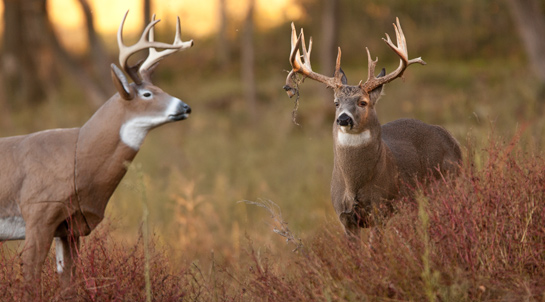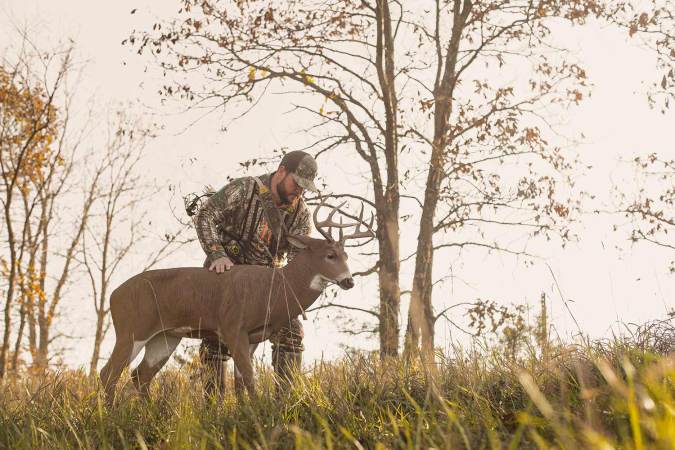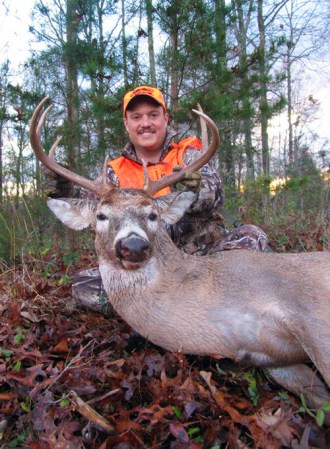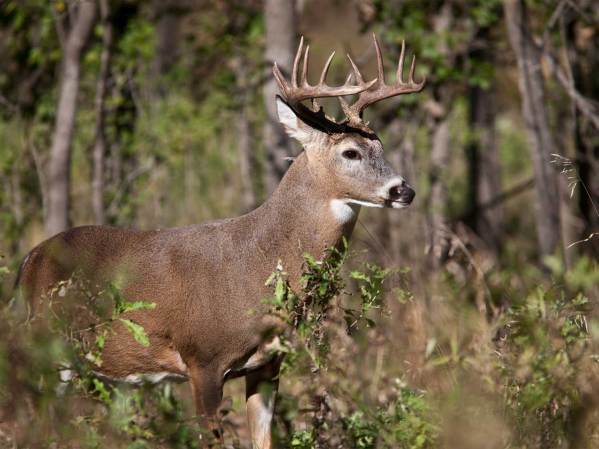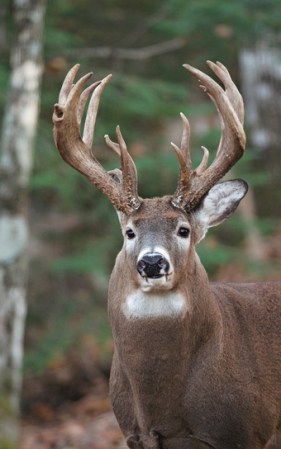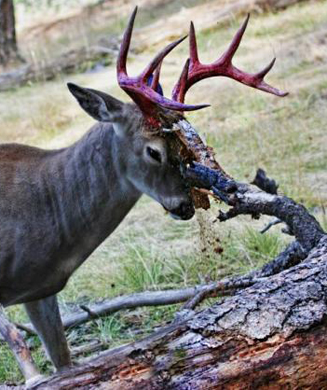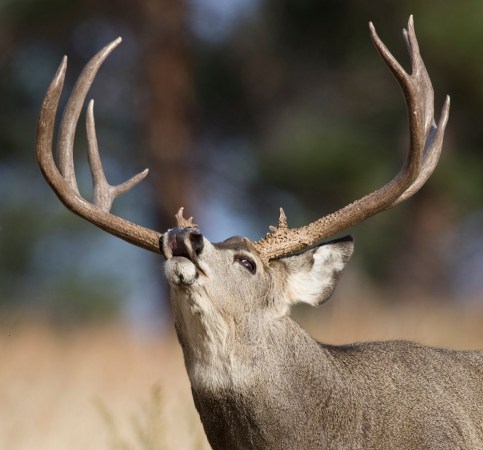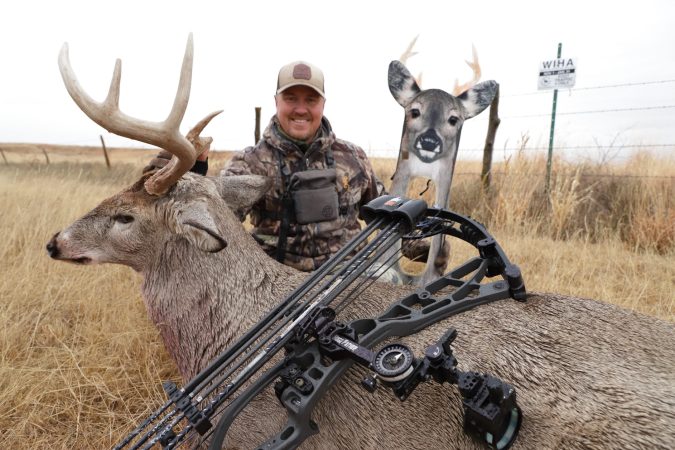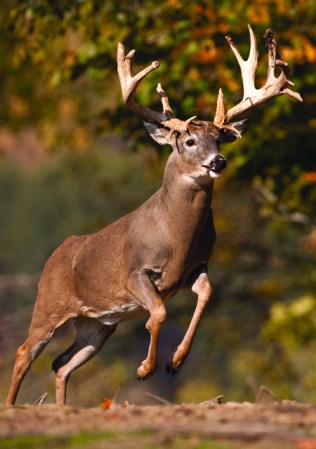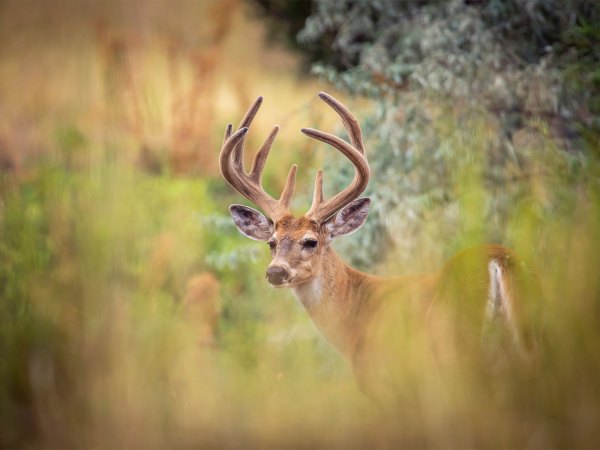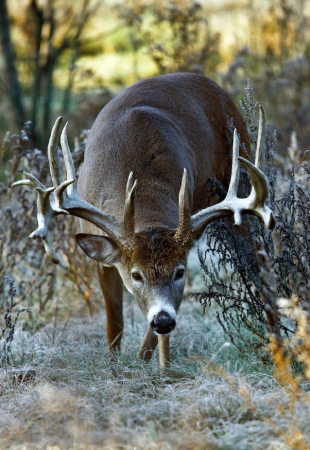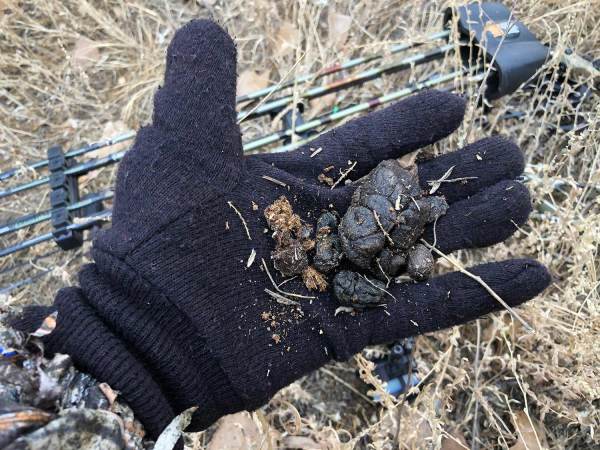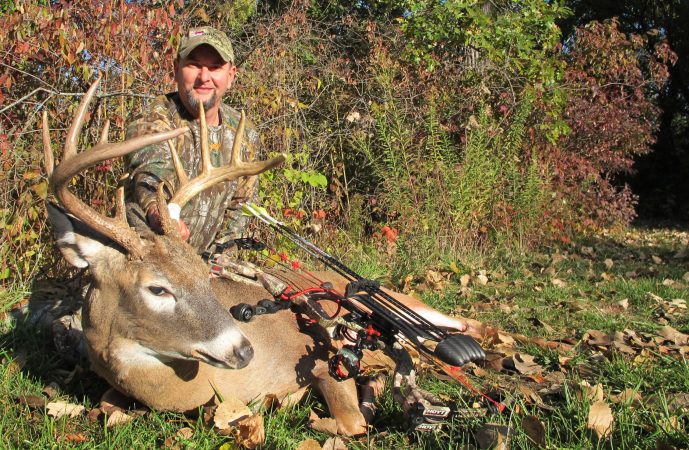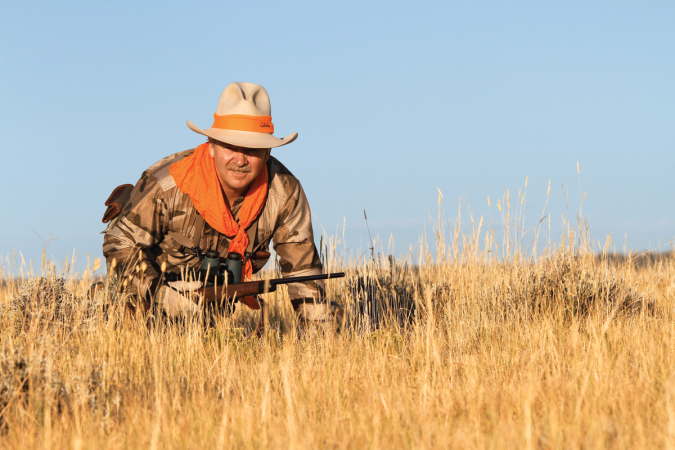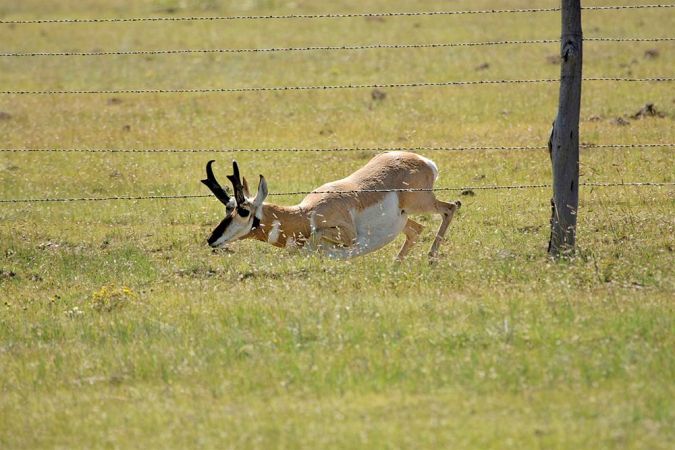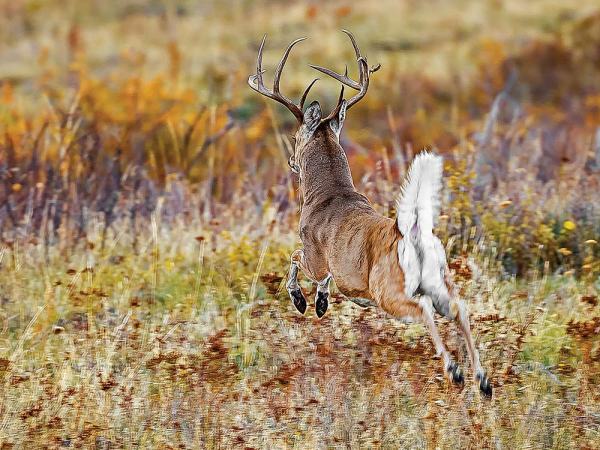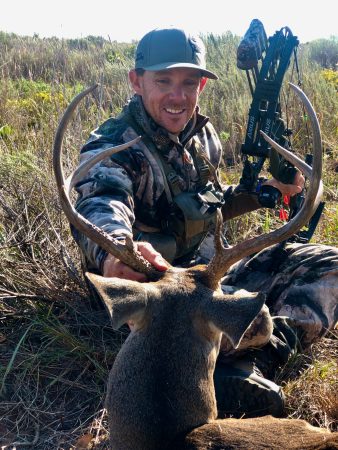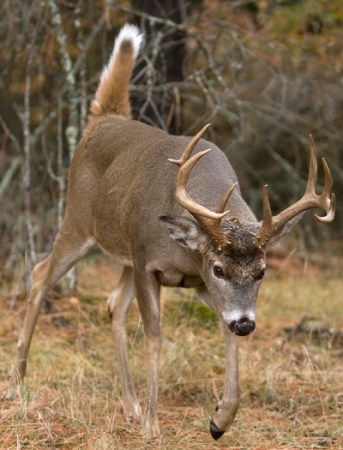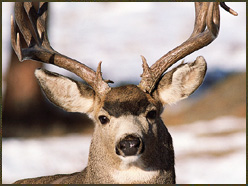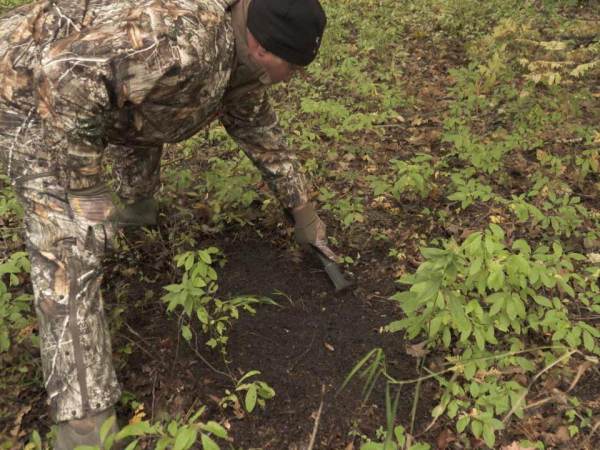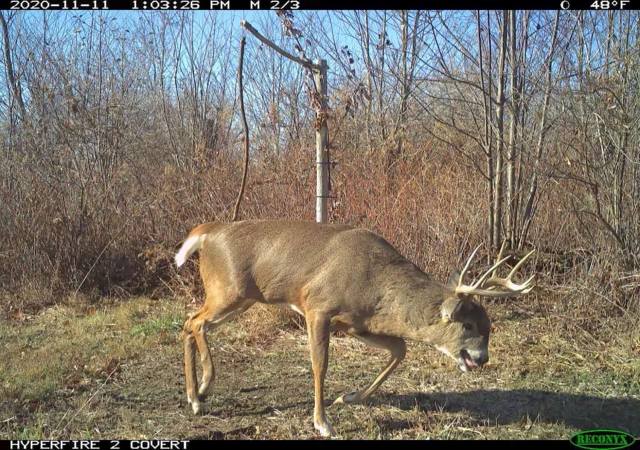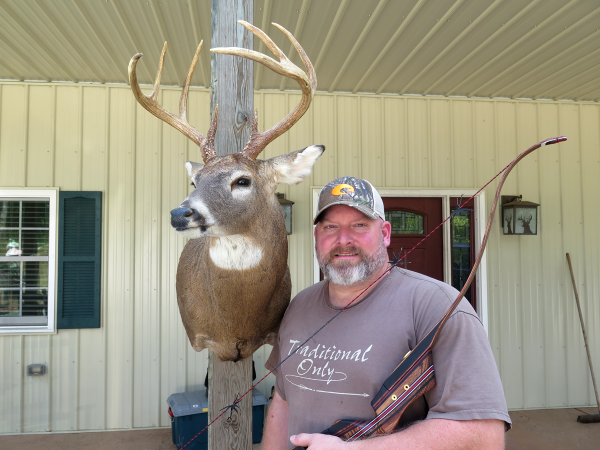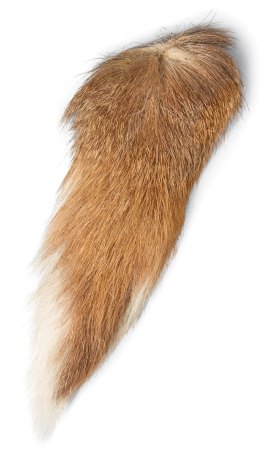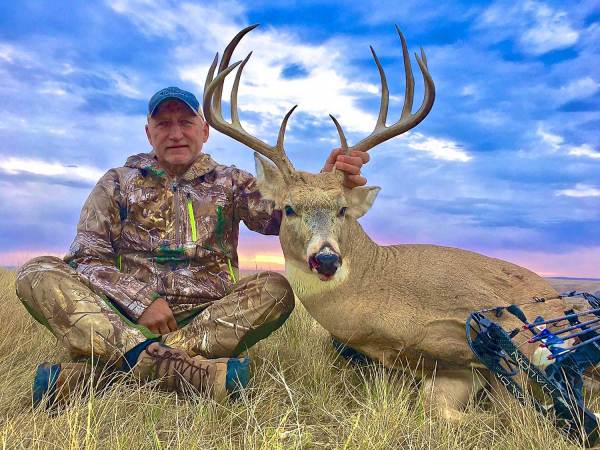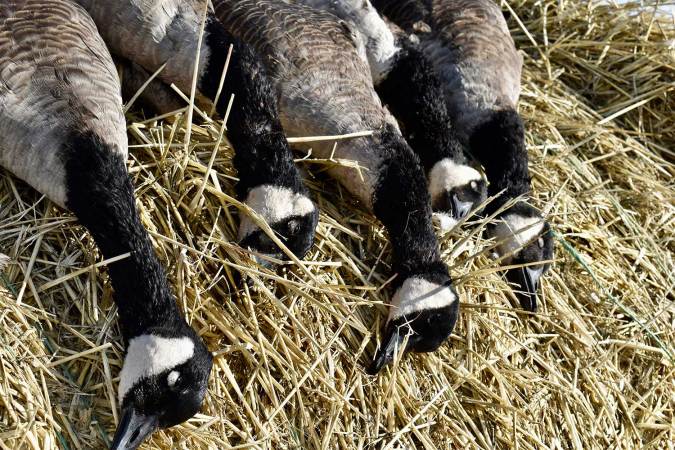We may earn revenue from the products available on this page and participate in affiliate programs. Learn More ›
November 6, 2003. Central Iowa. After two days and two nights of hard rain, the skies have finally cleared in central Iowa. To a Minnesotan like me, it’s a cool November morning. To someone who calls the South home, this is cold. I’ve been hunting dawn to dark for 14 days straight, yet my fire burns hot—hot enough that I’m in my stand a full 10 minutes before shooting light.
I’m pulling my bow up into the stand when I hear a long, guttural, angry grunt. I glance up, and standing 40 yards away in the frost-cloaked bean stubble is one of those giant Iowa bucks that bring us to places like this. The buck is locked in on Rufus, my well-traveled buck decoy. Slowly I pull the bow up to my stand, unhook the pull-up rope, slip an arrow from the quiver and, without taking my eyes off of the buck, nock the arrow on the string.
The buck stands and stares, grunts again and then comes in, doing that sideways walk the way John Wayne used to saunter into a saloon full of bad hombres right before all hell broke loose. It’s too dark to make out any details, but I know the buck’s ears are laid back and the hair on his neck and back is standing erect. It makes him look big and bad, but this brute doesn’t need any help. He’s built like a bull.
Three, maybe four steps from the decoy, the buck stops. I know what he’s doing: He’s giving the decoy one last chance to turn tail. But Rufus never runs from a fight. I draw my bow, but it’s too dark. To fling an arrow now would be just that, a fling and a prayer. I let down the string and in a blur the buck makes his charge, hitting poor Rufus right on the point of his shoulder. My decoy goes airborne. Its head flies off. The big buck whirls and runs 20 yards out into the stubble. He stands and stares at his decapitated adversary for a minute and then starts pawing the ground and snort-wheezing. I’m shaking like a Friday-night poker player suddenly playing no-limit Texas Hold ‘Em with the big boys in Vegas. All I want the buck to do is hang around a few more minutes and I’ll have the light I need to make the shot. So I snort-wheeze back at him. He doesn’t like that. He snorts back and paws the ground all the harder. For two, maybe three minutes, we trade insults. Then he tires of this game, turns and walks away.
I collapse onto the seat of my stand like a 200-pound blob of camouflaged Jell-O.
Decoying deer isn’t difficult. It’s just a matter of doing a few things correctly each time you set out to hunt. Here are my top 10 tips for doing it right. Follow them, and deer will come in to your decoy. The rest is up to you.
1. WHY DECOYS WORK
First, a decoy allows you to pull deer in close that otherwise would pass out of range. Second, a decoy will give you better opportunities for good shots at deer, because their focus will be on the decoy, not you. Finally, decoying is a lot of fun. More than once, I’ve found myself laughing out loud at some of the antics deer display when interacting with a decoy.
2. LOCATION IS KEY
You’ve probably heard the old real-estate adage that says the three most important aspects of a property are location, location and location. Well, the same holds true for decoying deer. A decoy in the right location can be dynamite. A decoy in the wrong place is not only a real dud, it might actually hurt your chances of success.
The most important thing to remember about decoy placement is that the farther away a deer can spot the decoy, the better the odds are that it will come in to explore it. Field edges, clear-cuts and natural meadows are all good setup locations. If possible, try to set up the decoy on a rise, where it can be seen more easily. One of my favorite decoy setup areas is a ridgetop where fingers of timber jut into a field. This is a common terrain feature across much of the country. Deer will use these fingers to enter and exit the field and cross the ridge. Even if a buck crossing the field doesn’t see your decoy initially, it’s easy to get his attention with a little grunting or rattling.
Decoys can work in timber, too, but remember, deer need to be able to see the decoy from a distance or you risk spooking them when they suddenly encounter it at close range. In semi-open hardwoods, pastured timber or pine plantations, however, a decoy works very well. A long stretch of logging road where any crossing deer can see the decoy from a distance is also a good bet. An intersection of two logging roads is even better.
3. PLACE FOR YOUR SHOT
I’ve messed up enough opportunities to know what works best when it comes to decoy placement.
I like my decoy 20 to 25 yards upwind of my stand or ground blind. If I’m using a buck decoy, I face the decoy toward my stand. It can be angling left or right, but it needs to face in the general direction of your stand because when a buck comes in to a buck decoy he will nearly always circle downwind of it, then come in to face it head-on. This naturally puts him between your stand and the decoy for a closer shot.
If you’re using a doe decoy, always face it away from you. Again, you can angle it, but make sure it’s facing away from your stand. Bucks coming in to doe decoys are most interested in the hind end of the doe. (If I have to explain this further, you’re probably reading the wrong magazine.)
4. FOCUS ON THE HEAD
A buck wants to keep his eye on the other buck’s head. That’s where the weaponry is. I’m also convinced that bucks look each other in the eye, which is why I glue glass eyes like the kind taxidermists use on all of my decoys. It makes a difference.
5. COVER YOUR SCENT
Make sure the decoy smells like a deer and not like you. If your decoy has any human odor on it, a buck will whirl and run as soon as he gets downwind, no questions asked. To prevent this, handle your decoy with gloves and spray it with Scent-Away odor neutralizer (H.S. Scents, 800-728-0321) each time you set it up.
Then sprinkle a little deer scent around. You can use doe-in-estrus, buck urine, straight doe urine or tarsal gland scent. All seem to work.
Before I became extremely cautious about controlling foreign and human odor, I used to apply deer scent directly to the decoy. That was a mistake. You don’t want to get the deer scent on yourself or your outer layer of Scent-Lok while you handle the decoy. Instead, take a stick and jab it into the ground under the decoy. Hang a cotton ball or scent wick on it, and apply your favorite scent. Or do as my buddy Greg Miller does and just spray some deer scent on the ground under the decoy. The whole purpose of using scent is to encourage the buck to hang around the decoy a little longer. Anything you can do to accomplish this will boost your chances that the buck will offer the perfect angle for a shot.
6. MAKE IT MOVE
You can pull in plenty of deer with a motionless decoy, but there’s no doubt in my mind that you’ll pull in even more with one that moves. What often happens with a stationary decoy is that the buck will hang up out of bow range and stare at the decoy, waiting for it to make a move. If it doesn’t, the buck might get nervous and walk away.
There are many ways to add movement to your decoy. Where it’s legal, you can use battery-operated decoys or devices that attach to your decoy to make its tail wag. Rufus, my favorite, is a full-body buck mount from Custom Robotic Wildlife (715-692-3000). These are the same decoys conservation officers use to catch poachers, so they’re very lifelike. You can make either the tail or the head move, but the head movement is far more effective.
Over the years I’ve had dozens of bucks hang up when they approach old Rufus. But when I move his head, it’s a done deal. So far, every one of them has come on in. As you might expect, these decoys are expensive (about $1,000), but if you hunt where they’re legal, they can be deadly.
Want a cheaper solution? For about 25 cents worth of fishing line, you can attach a white rag to the rear of your decoy and run some fishing line up to your tree stand or into your ground blind. Jerk the line when a buck is staring down your decoy. Then watch the fireworks begin.
Another inexpensive trick is to cut some 1- by 4-inch strips from a white plastic garbage bag. Make sure it’s a cheap bag. The expensive ones are too thick and don’t flap in the breeze as well. Use duct tape to attach one strip to each ear and another to the rump.
A slightly more expensive idea is to buy a replacement tail from Martine’s (219-992-3802). These tails are made of a superlight synthetic material and move with just the slightest breeze.
7. BUCK OR DOE?
Most of the time I use a single buck decoy. If I use two decoys, I use a buck and a doe together. I rarely use a lone doe decoy because they simply attract too many deer. Put a doe decoy out in a field and you’ll most likely attract a bunch of does and fawns. That’s great, you figure; now you’ve got live, legal decoys. But invariably, there will be one old, fussy, super-nervous doe. All of the other deer will accept the fake and go about their business. But this old girl knows something isn’t right. She’ll stalk around the decoy and stomp her front hooves in an effort to startle the decoy. Eventually she’ll start snorting and blowing, and all the does will leave the field. Worse yet, she may move a short distance from the decoy but continue to blow and snort at the fake. None of this is good unless you’re hunting does.
However, if you use a buck decoy (especially during the rut), does will usually stay away, which is good. Another reason I like buck decoys is that several times I’ve had bucks leave a hot doe they were trailing or tending and come over to kick my buck decoy’s butt. I’ve never had one leave a hot doe to investigate a doe decoy.
8. TRY A SILHOUETTE
Are silhouettes as good as full-bodied decoys? No, but they’re close. I’ve decoyed in dozens of bucks with silhouettes, and not once has a buck shown any indication that he thought something wasn’t quite right. If it comes down to using a silhouette or no decoy at all, I’ll opt for a silhouette.
Because they’re light and easy to carry, I usually use two Montana Decoys (406-748-3092) and position them so that no matter what quarter a deer might approach from, he will be treated to a broadside view of one of them.
9. MAKE SOME NOISE
Many hunters simply put out a deer decoy and wait for a deer to come along and see it. You’ll decoy some deer this way, but not nearly as many as you will if you encourage deer to seek you out. The way to do this is to spend a lot of time grunting, bleating and rattling. Don’t be shy. The more you call and rattle, the more likely it is that a buck will come looking for the source of the racket and spot your decoy. I’ve never kept track, but I’m sure that half of the bucks I decoy each year are initially attracted by either calling or rattling.
Decoying is very effective, and best of all, it adds even more fun to an already enjoyable activity. Make this the year you give decoying a try. You just might get the surprise of your life when that big boy walks in.
10. TIME YOUR ATTACK
Deer will come to the decoy anytime during the season, but the very best action is late in the pre-rut or during the rut itself. The six-week stretch from mid-October to late November is prime time for most of the country.
If you spend all season bowhunting one or two small woodlots, as many hunters do, don’t break out the decoy until just before the first wave of does goes into estrus (the last few days of October through the first week of November in most northern-tier states). Bucks are beside themselves by this time, and very few will be able to ignore a decoy. The problem with using a decoy early in the season is that you run the risk of educating deer to the decoy before prime time. If you have plenty of ground to hunt, it lessens that risk.
For information on how to order Gary Clancy’s book Rattling, Calling & Decoying Whitetails, write to Out There, 12105 Oak Ave. SW, Stewartville, MN 55976.

